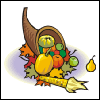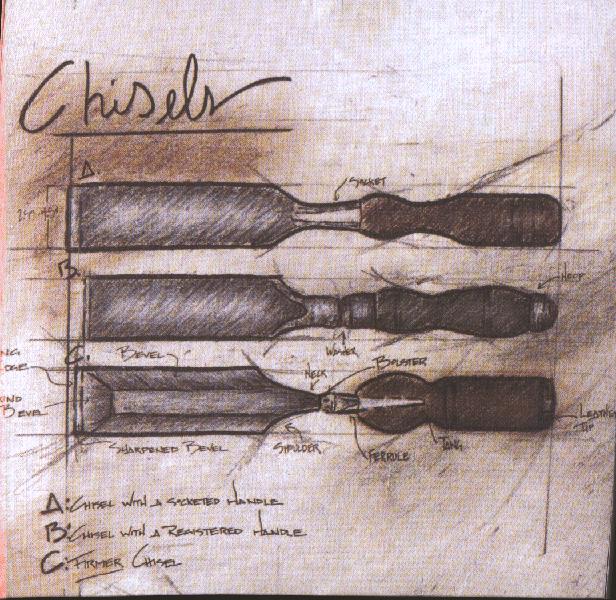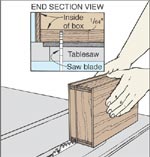SPLINTERS
Tennessee Valley Woodworkers

 Vol. 19/ Issue 11
November 2004
Editor: Tom Gillard Jr.
Vol. 19/ Issue 11
November 2004
Editor: Tom Gillard Jr. 

Meeting Notice:
The next meeting of the TN Valley Woodworkers
Will be held, November 16th at 7:00 p.m. in the
Duck River Electric Building, Dechard, TN
All interested woodworkers are invited!


The following people have agreed to serve as contacts for their particular
skills. If you have questions, suggestions for activities, or other
comments relating to these skills, please call these folks. Their
interest is to help the club better serve their area of expertise.
Your participation with them will help them achieve that goal.
Tom Cowan
967-4835 Design Phil
Bishop 967-4626
Finishing
Tom Church 967-4460
Turning Harry
May 962-0215
Carving
Bob Reese
728-7974 Sharpening Ross
Roepke 455-9140 Jointery
Maurice Ryan 962-1555
Health and Safety 
List of Club Officers
President: Ken
Gould
V. President: Barbara
Keen
Secretary: Chuck
Taylor
Treasurer: Henry
Davis
Publicity: Larry
Bowers
Webmaster: Richard
Gulley
Newsletter Editor: Tom Gillard
Jr.

Please remember, in your thoughts and prayers, all of the Military
Troops serving our country.
Calendar of Events:
December 10th: TVW Christmas Party
December 9th-19th Pinocchio Play
November Program
Doyle has agreed to do the program on Wood and computers.
Maybe now we will be able to understand how he makes those beautiful
sculptures from a bowl.
Nominations for the 2005 TN Valley Woodworkers Club
President:
Loyd Ackerman
VP:
Tom Cowan
Seceratary:
Chuck Taylor
Treasurer:
Henry Davis
Publicity:
Larry Bowers
Newsletter Editor: Tom Gillard Jr.
If there are any other nominations, they can be voice at the meeting.
Pinocchio Play
This is a reminder of the Tennessee Valley Woodworkers Exhibit at the
Manchester Arts Center during December 2004.
The Pinocchio play will be playing from December 9 to December 19 at
the Manchester Art center. The actual show dates are 9-10-11-12 and
17-18-19. Sunday show times are 2:00 PM. All other days are
7:30 PM.
There will be a 20-minute intermission between the first and second
acts. Viewing in the exhibit area and lobby is before and after the
show and during intermission. A MAC monitor will be at the exhibit
room door to ensure that an adult accompanies children.
Any wood item is welcome, but the hope is that members will provide
some items related to the theme of the show; either Pinocchio figures or
something in the line of toys.
I talked to the director and found out that the play will cost $8 for
adults and $5 for children. At this point, the word is that exhibitors
will have free access to the exhibit, but will have to pay if they want
to attend the play.
Final arrangements will be announced as they develop.
The MAC staff is arranging publicity for the event.
Thanks for your interest in the exhibit. If you have any questions,
contact me at 931-728-9952. Loyd
SHOW and TELL
Harry May displayed some of his excellent carvings. They included
three
wood spirits (carved from box elder) and a carving of 'Jiminy Cricket'
(to be displayed at the Manchester Arts Center exhibit).
Tom McGill brought a cherry
table leg that he had made. The leg had a beaded section and Tom did
this process on his lathe, utilizing a router and fixture.
Joe Kuhn discussed a 'Bead-Lock' system that he had purchased
for creating mortise/tendon joints. He explained the system and showed
how to create the joints. He also brought a $900 'cleaning
supply caddy' made from clear pine and put together with box joints.
The reason for the great expense of the small project was that he used
the project to justify the purchase of a new band saw.
Bob Leonard displayed a 'pig'
knife that he had carved, after purchasing the first one. The knife was
maple with cherry blades. He also discussed how he made a small piece of
molding, utilizing a homemade scraper.
Chuck Taylor brought two small
box elder bowls finished with two coats of lacquer. The bowls were
'identical' except for the 'differences'.
Doyle McConnell brought a red
maple vase with a lacquer finish and his latest creation a 'Fibonacci'
design created from a red maple closed vessel. The creation was displayed
on an iron stand made by Ken Gould.
Geoff Roehm discussed a 'drop
spindle' made from bodark and walnut burl. He used a metal cutting
lathe to make the piece.
Tom Gillard showed two sail
boats that he had made. The hulls were magnolia and sails were made
from maple. Tom also brought sample panels
the he was making for a second story
railing, required to meet local building codes.
New York City's Royal Paulownia
Empress Tree Background
The United States has stands of Royal Paulownia all along it's Eastern
Seaboard. The most beautiful of these are in New York City's Central Park.
The older Paulownia in U.S. parks and botanical gardens look very different
from trees planted by commercial growers who demand a straight, limbless
trunk and fast growth.
Legend has it that Royal paulownia was named in honor of Princess Anna
Pavlovna, daughter of Russia's Czar Paul I. Other names for the tree are
empress tree, princess tree and karri. Paulownia was first introduced into
the United States in packing material (seed pods) sent from China where
the tree is a native species. Shortly after that the tree found its way
into Central Park.
Facts About Planting, Growing and Marketing the Empress Tree
Paulownia tomentosa has marvelous press on the Internet. Several Australian
and United States companies make claims of extraordinary growth, unbelievable
wood values, magnificent beauty; Paulownia, they write, can shade an area
in record time, resist insects, feed livestock, and improve the soil component.
Is this just hype, or is the plant truly a "supertree"? Let me introduce
you to Royal Paulownia (other names are Empress Tree, princess tree, kawakami).
You make up your own mind.
The Empress Tree
Right away you know the tree is very special. The plant's pedigreed
and regal names include Empress Tree, Kiri Tree, Sapphire Princess, Royal
Paulownia, Princess Tree, and Kawakami. The surrounding mythology abounds
with several cultures claiming title to the plant's legends.
Probably the Chinese first linked a tradition with the tree. The oriental
Paulownia is planted when a daughter is born. When she marries, the tree
is harvested to create a musical instrument, clogs, fine furniture, and
they live happily ever after. In actuality, it is a valued wood in the
orient and top dollar is paid for its procurement.
Legend also insists that it was named Royal Paulownia in honor of Princess
Anna Pavlovnia, daughter of Russia's Czar Paul I. Unlike Paul Harvey, I
can't seem to find the rest of the story...
The United States has stands of these trees all along the Eastern Seaboard
and through the midwestern states. Paulownia's range is said to have expanded
because of the seed pods used in packing shipped cargo from China. Containers
were emptied, winds scattered the tiny seeds and a "fast forest" developed.
The tree has been in America since the mid-1800s. It was first "discovered"
as a profitable tree in the 1970s by a Japanese timber buyer. This sparked
a multi-million dollar export market for the tree. One log is said to have
sold for US$20,000.
The wood has been ignored by domestic companies in the United States
but utilization studies (which I have not been able to find on the Internet)
have been done by several universities, including Tennessee, Kentucky,
Maryland, and Virginia. Planting the Paulownia tree, says Fred Wright,
Carolina-Pacific International, Inc., is a reaction to the "failure of
our domestic forests to meet a growing demand, coupled with man-made crises"
which have led to declines of the spotted owl and the red-cockaded woodpecker.
Steve
Nix,
Click HERE
to
see photo of last month's carving seminar at Phil's shop.
Sawing off a lid is easier if you don't quite cut itů

When separating the lid from a small box using a tablesaw, the parts
can pinch together, making things go haywire in a hurry.
Set your tablesaw's cutting depth about 1/64" less
than the thickness of your box sides and ends. Then, cut along the lid
separation line as usual; the two parts will remain joined. Complete the
job by cutting the lid free with a craft knife and sanding the edges of
the lid and box.
--Arthur Conway, Biggera Waters, Queensland, Australia
Wood-Online
See you
on the 16th.
click on the image to go to these sites
Donations to the club have been made by these companies.
Thanks,



 Vol. 19/ Issue 11
November 2004
Editor: Tom Gillard Jr.
Vol. 19/ Issue 11
November 2004
Editor: Tom Gillard Jr. 
![]()
![]()
![]()
![]()

